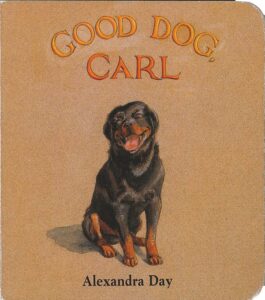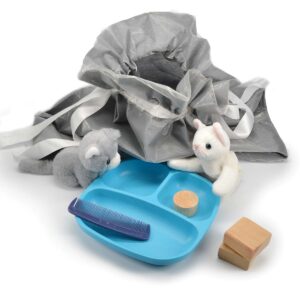Receptive language, Expressive language
A toddler helps a caregiver tell a story from pictures in a wordless book.

Good Dog, Carl by Alexandra Day


 [Invite a toddler to help you tell a story about a dog and a baby. Sit next to the toddler for sharing the book. Show the book cover and point to the picture of the dog and the book’s title when you describe each.]
[Invite a toddler to help you tell a story about a dog and a baby. Sit next to the toddler for sharing the book. Show the book cover and point to the picture of the dog and the book’s title when you describe each.]
Our book is about a dog and a baby. The dog’s name is Carl. Here is a picture of Carl. Our book is called Good Dog, Carl.
This is a silly book. Carl and the baby do lots of things that a real dog and a real baby would not do.
[Point to text on the first and last pages as you describe each.]
Most books have words that tell a story. Our book is special. Our book has words on the first page. Our book has words on the last page. There are no words on the other pages of our book!
What can we do to learn about the story told in our book? (look at the pictures)
The pictures in our book can tell us a story. We can look at each picture and try to figure out what is happening.
[Open the book. Invite the toddler to hold the book or to hold the book with you and turn the pages.
Read the first page and point to related features of the illustration, such as the mother wearing her coat and carrying her purse. Draw attention to the baby in the crib. On the next and subsequent pages, use the following strategies to support the toddler in telling a story:
It is not necessary to discuss each picture or situation. Follow the toddler’s lead regarding what is of interest in the book.]
Most book have words that tell a story. Our book has almost no words. We looked at pictures to tell a story about a dog and a baby. Carl and the baby did many silly things together.
Pay close attention to the toddler’s reactions to the book’s pictures so you know how much and what type of support to provide for helping the toddler contribute to the storytelling. Provide just enough assistance for the toddler to be a storyteller. With some pictures, it may be sufficient to simply name or describe an object. For example, explaining that a picture shows a large tank of water for fish may be all the information a toddler needs for describing how the baby is swimming in a tank with fish. Offer pauses that give a toddler time to look at a picture and an opportunity to talk. Anticipate different experiences across toddlers in this activity: some may eagerly embrace a storyteller role, others may enjoy sharing the storyteller role with you, and other toddlers may strongly prefer that you take the lead in telling the story.
Some other activities in the ELM Curriculum for older toddlers (24–36 months) offer opportunities for a child to tell a story. Usually the storytelling opportunity supports recall skills because it occurs after a toddler has heard a story read by a caregiver. The current activity promotes language use with a wordless book the toddler may not know.
Extra support
Enrichment
Receptive language, Expressive language
A toddler helps a caregiver make up and tell a story from familiar items in a “story bag.”



Be Prepared: Secure up to 10 items available in your room that you anticipate will be of interest to the toddler who participates in this session. Include items that are familiar, and less familiar, to the toddler. Also, select items that do not necessarily go together in play or use. Example: a doll and a block. Place the items in the cloth bag, known as a “story bag” in this activity.
 Invite a toddler to look at what’s inside a bag. Explain the bag is our “story bag” because we can use things in the bag to make up a story. We can use things we want to use for a story. We do not need to use everything that is in the bag. We can make up one story, or we can make up many stories. Encourage the toddler to remove items from the bag and say the name of each. Keep the items fully visible during the activity.
Invite a toddler to look at what’s inside a bag. Explain the bag is our “story bag” because we can use things in the bag to make up a story. We can use things we want to use for a story. We do not need to use everything that is in the bag. We can make up one story, or we can make up many stories. Encourage the toddler to remove items from the bag and say the name of each. Keep the items fully visible during the activity.
Begin the storytelling with one or two items that you hold or put in front of you and the toddler. Make up a simple story about the item(s) and invite the toddler to add to the story. Example: “Our kitten is drinking some milk. Slurp, slurp, slurp. Now the kitten is running. Run, run, run. The kitten is jumping over a fence (block). The kitten is chasing something. What do you think the kitten is chasing? What happens next?”
Do actions with the story items, such as moving the kitten figure in running and jumping actions. A toddler may or may not want to do actions with his/her story contributions.
Offer an opportunity for the toddler to begin a story. Example: “You’re looking at (or holding) a comb. What could the comb do with something else that you found in the story bag?” Suggest an item, such as a bowl, if the toddler seems uncertain. If the toddler makes up a story (which could be as simple as one sentence), add to the story or use questions to encourage the toddler to tell (make up) more.
If the toddler does not offer a story with the items, make up a story and invite the toddler to add to the story. Example: “I’m going to pretend I am a comb that sits in this bowl at the place where people get their hair cut. The person who cuts hair picks me up and moves me through a girl’s hair. The hair is long. I am getting tired being in the girl’s hair! Oh good, the girl’s hair is done. I am sitting in the bowl again. Now the person who cuts hair is cutting a boy’s hair.
I am being picked up so the boy’s hair can be combed.” Invite the toddler to add to the story. Example: “What will it be like to be a comb in the boy’s hair?”
Initiate as many stories as toddler interest and time permit. Conclude the session by recalling highlights of the stories told during the session. Emphasize the toddler’s contributions and/or reactions. Examples: “You said the kitten was chasing a dog. The dog got scared and ran home!” “You laughed when I pretended to be a comb getting tired in a girl’s long hair.”
Each “story bag” session will be different because the items you select are tailored to a toddler’s interests. No story is likely to be told more than once. Sessions also will be different across toddlers due to language skills and interest in making up and telling stories. Some toddlers may be reluctant to contribute verbally (see Extra Support tip), whereas other toddlers may create small pieces of a story or tell an entire story. It is fine if a toddler describes actual, not make-believe, use of an item in the “story bag.” Exposure to and participation in language use are valuable aspects of the activity. Emphasize simple stories.
This activity option is more challenging than Option 1 because the props offer less information than the pictures in the Option 1 book. However, the props offer important storytelling advantages that you can accentuate in the session, including opportunities to manipulate actual object(s) in creative ways.
Extra support
Enrichment
Materials Needed: familiar picture book, such as Goodnight Moon by Margaret Wise Brown; items that connect with the selected book (such as mittens and a cow figure for Goodnight Moon)
Place the book and items on a low table. Invite toddlers to look at the picture book and explore the related items. Encourage toddlers to select several of the items to tell a story. Toddlers may wish to talk about items as used in the story or create their own story. Some toddlers may enjoy engaging in pretend play with the props.
Materials Needed: see activity description
Extend Option 2 by inviting older toddlers and preschool-age children to each select 1–2 objects in your setting to put in a “story bag.” After items are collected, encourage children to use some of the items to tell a story. Initiate and support storytelling with strategies suggested in Option 2. Some children may enjoy drawing a picture of a story told during the activity.